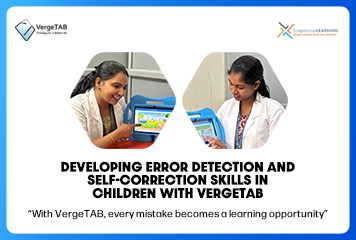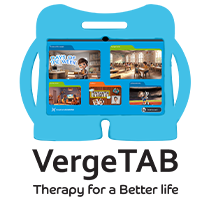Developing Error Detection and Self-Correction Skills in Children with VergeTAB
03 Oct 2025

Mistakes. We all make them, even as adults. As children grow up, they make millions of big and small mistakes. Helping them recognize and fix these is to provide them with a skill for a lifetime. For children with learning differences, autism, or ADHD, this is even more important as understanding errors and making corrections nurtures in them a much-needed independence, sharpens their focus, and builds resilience.
With the right support, therapy sessions can become spaces where kids practice noticing when something is not working, thinking through the problem, and trying again. This kind of support sharpens their focus, and builds confidence and independence. Digital tools can be especially helpful in creating these structured learning moments. XceptionalLEARNING’s VergeTAB, offers interactive activities designed to support this process. Its custom-designed activities transform therapy sessions into interactive correction labs, using structured digital tools to strengthen error detection, self-monitoring, and problem-solving. By guiding children to identify, reflect, and fix mistakes, VergeTAB encourages the mindset of “learning from every mistake,” laying the foundation for more confident, independent learners.
Self-Correction in Therapy
Error detection and correction has multiple benefits for children:
- Boosts confidence by allowing children to realize their progress.
- Reduces dependency on adults during academic and everyday tasks.
- Builds resilience by teaching kids to handle mistakes positively.
- Encourages logical reasoning and reflective thinking.
Self-Correction with VergeTAB
Unlike traditional exercises, VergeTAB’s interactive, fun, and visual-based activities make error correction feel like a rewarding challenge, not a punishment.
Paired with the XceptionalLEARNING Platform, VergeTAB offers:
- Structured therapy sessions tailored to each child’s developmental goals.
- Interactive digital exercises like sequencing, visual corrections, and social reasoning games.
- Real-time progress tracking, which provides immediate feedback.
- Customizable learning flows, adaptable for therapists, special educators, or parents.
VergeTAB’s strength lies in its flexibility: whether in one-on-one therapy, classroom settings, or home routines, it adapts to meet the child’s individual needs.
10 Practical Self-Correction Activities Using VergeTAB
1. Picture Error Spotting– Visual Logic & Self-Monitoring
Goal: Develop visual reasoning and self-monitoring.
Activity Idea:
- Use complex real-life scenes via XceptionalLEARNING.
- Include 3–5 subtle mistakes (e.g., out-of-place objects, logical errors) and ask them to:
- Find and correct mistakes with drag-and-drop.
- Explain verbally why it’s wrong.
- Gradually add multi-step errors (e.g., sequence + object mistakes) and repeat the process.
Use in Therapy:
- Speech Therapy: Builds expressive language as children describe mistakes.
- Special Education: Enhances visual logic and self-awareness.
- Behavioral Therapy: Promotes reflective thinking.
- Occupational Therapy: Improves visual attention and fine motor skills through touch interactions.
2. Sequencing Correction: Fixing Mixed-Up Routines
Goal: Improve sequential logic and organizational skills.
Activity Idea:
- Present 5–7 step sequences via XceptionalLEARNING (daily or academic tasks) and ask them to:
- Arrange steps in order.
- Narrate sequences with proper connectors.
- Advance to abstract sequences (life events, story plots).
Use in Therapy:
- Occupational Therapy: Reinforces daily living routines and step planning.
- Special Education: Builds academic sequencing skills.
- Speech Therapy: Supports narrative development.
- Behavioral Therapy: Encourages task focus and reduction of errors.
3. Visual Closure Matching: Completing the Whole
Goal: Build independence in daily routines.
Activity Idea:
- Use life skills visuals with intentional errors, and ask them to:Â
- Identify and correct mistakes (e.g., wrong clothing, improper food storage).
- Explain proper steps.
- Customize with child’s routines.
Use in Therapy:
- Occupational Therapy: Strengthens visual-motor integration.
- Special Education: Reinforces cognitive closure skills.
- Speech Therapy: Develops descriptive vocabulary.
- Behavioral Therapy: Improves sustained attention.
4. Social Scenario Fix-it Games: Correcting Social Errors
Goal: Develop anticipation and foresight.
Activity Idea:
- Show paused social/daily life scenarios, and ask them to:Â
- Predict outcomes and suggest correct actions.
- Progress to multi-option predictive reasoning.
Use in Therapy:
- Behavioral Therapy: Builds social awareness and positive behavior correction.
- Speech Therapy: Enhances social communication.
- Special Education: Supports classroom behavior readiness.
- Counseling/Psychology: Reinforces self-reflection in social settings.
5. Quick Self-Checking Academic Challenges
Goal: Train quick thinking and focus.
Activity Idea:
- Provide 10–15 second challenge rounds via XceptionalLEARNING, and ask them to:
- Identify/correct errors fast.
- Mix maths, visuals, and language.
- Track progress with scoreboards.
Use in Therapy:
- Special Education: Builds early maths self-correction skills.
- Behavioral Therapy: Encourages perseverance in learning tasks.
- Occupational Therapy: Combines motor planning with academic focus.
- Speech Therapy: Can incorporate verbal counting and maths vocabulary.
6. Functional Life Skills Correction
Goal: Enhance advanced categorization and flexible thinking.
Activity Idea:
- Show objects/images with overlapping features (color, size, category), and ask them to:
- Sort based on dual/triple attributes (e.g., red animals, large fruits).
- Increase complexity with category shifting mid-task.
Use in Therapy:
- Occupational Therapy: Teaches practical life skills through visual routines.
- Special Education: Supports functional academics.
- Behavioral Therapy: Reinforces independence in tasks.
7. Predictive Correction: What Happens Next?
Goal: Build thinking-about-thinking skills.
Activity Idea:
- After each task on VergeTAB, prompt self-reflection questions:
- “What helped you decide?”
- “What would you do differently?”
- Use visual emotion meters to rate feelings after the task.
Use in Therapy:
- Speech Therapy: Encourages the development of story-building and problem-solving language skills.
- Behavioral Therapy: Builds impulse control through future planning.
- Special Education: Improves cognitive flexibility.
- Psychological Counseling: Strengthens decision-making awareness.
8. Time-Limited Error Spotting Games
Goal: Improve object recognition from incomplete visuals.
Activity Idea:
- Use partial images (half-hidden objects) on VergeTAB, and ask them to:
- Guess and reveal the full image.
- Match incomplete to full pictures.
- Progress from basic shapes to complex scenes.
Use in Therapy:
- Behavioral Therapy: Improves focused attention.
- Special Education: Makes correction tasks dynamic and rewarding.
- OT: Enhances visual-motor coordination.
- Speech Therapy: Promotes rapid language retrieval.
9. Building Self-Monitoring Habits with Progress Tracking
Goal: Strengthen multi-sensory connections.
Activity Idea:
- Combine sound cues with visuals (e.g., match animal sound to image), and ask them to:
- Tap the correct image after hearing a sound.
- Drag and link images and sounds in sequences.
- Optionally use vibration cues if applicable.
Use in Therapy:
- Special Education: Improves self-directed learning habits.
- Behavioral Therapy: Reinforces positive behavior change.
- Speech/ Occupational Therapy: Encourages visual goal tracking.
- Psychological Counseling: Builds self-confidence through measurable success.
10. Reinforcement and Rewards for Self-Correction
Goal: Promote adaptive reasoning with multiple solutions.
Activity Idea:
- Show problem scenarios with more than one solution (e.g., how to cross a river). Then, ask them to:
- List multiple solutions or choose different tools to solve.
- Discuss pros/cons of each.
- Scale from simple puzzles to social dilemmas.
Use in Therapy:
- Behavioral Therapy: Supports reward-based learning systems.
- Special Education: Motivates continued task engagement.
- Speech Therapy: Encourages corrected speech productions.
- OT/Psychology: Builds resilience through positive reinforcement.
Suggested Session Flow Using VergeTAB
A structured session on VergeTAB can follow this format:
- Warm-Up (5 minutes): Quick visual or auditory spotting games.
- Core Session (30 minutes): Main activities targeting self-correction, selected based on therapy goals.
- Cool-Down Reflection (5 minutes): My Fix-It Journal with emotional reflection.
- Progress Tracking: Weekly reviews through XceptionalLEARNING dashboards to monitor growth in accuracy and independence.
Conclusion: Building Lifelong Independence Through Self-Correction
In therapy, progress is not just measured by correct answers but by the ability to identify and fix mistakes independently. VergeTAB empowers children to build this essential skill through real-time feedback, interactive correction tasks, and reflective learning loops. By using error correction as a positive learning opportunity, children develop resilience, confidence, and self-control that extends beyond therapy sessions. Whether at home, school, or therapy centers, VergeTAB support a growth mindset where mistakes become stepping stones to mastery.Â
Empower your child’s growth with VergeTAB — a Digital Therapy Activity Device and Interactive Learning Device for Children—perfect for Hybrid Model Therapy at home, school, or therapy centers. Contact us today to get started!


